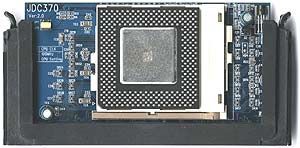Along with a Celeron 500 processor (SL3FY, week 1,
Malaysia in our case) you get a blue coloured slocket, and a decent fan & heatsink to keep things nice and cool.
 |
The Performa comes with a socket 370 heatsink and shrouded
fan. A thermal pad on the base is used in place of thermal
compound. The base of the heatsink is brushed, so if the thermal pad were
removed, a healthy dose of thermal goo would be a good
idea.
The fan has a motherboard connector - for RPM monitoring -
or it can be hooked up via pass-through Molex
connectors. |
|

|
|
The slocket is a
funky blue coloured one, with a SECC2 framework to assure it stays locked in the slot.
Slockets with large heatsinks can some times wobble in the slot if the
computer is getting moved around. Occasionally this will cause a system crash to
occur. These little plastic enclosures pretty much stop that from
happening.
The socket also has a jumper to allow switching from
'CPU setting' to '100Mhz clock setting'. |
Benchmarks:
It's such a nice feeling to double
the clock speed of one's computer with a few seconds of
tinkering. Obviously there was a significant increase in Performance of
standard Win98 applications. Using Sandra we benchmarked the differences between the old Pentium II 233Mhz,
and the new Celeron 500 on our Abit BX6 motherboard.

We ran Sandra's CPU benchmark on two different processors
and then with the 500Mhz Celeron upgrade. Moving from a PII-233Mhz to the
Celeron 500Mhz shows a full doubling in results, with drhystones moving up 723,
and whetstones up by 358! For those of you who have a Celeron 366, an
upgrade to the 500Mhz model shows an increase of 361 drhystones, and 179
whetstones - a very respectable increase in Performance.
I think
it would be safe to say that this upgrade will not be landing
in the hands of eager overclockers. Commercial systems from the likes
of Dell and IBM have never been a good starting point for overclocking... Enough
said.
Conclusions
In conclusion, the Performa 500 (500Mhz Celeron upgrade)
does what it's supposed to, and at a fairly competitive price. The inclusion of
good BIOS flashing instructions and trouble shooting tips for Windows error
messages are where this upgrade really shines. Too often, non-tech savvy people are forced to drop off their computer with a shop, wait a day to
have their stuff upgraded, and never know how to do it themselves. This
upgrade offers, through clear instruction, an easy way for just about
anyone to upgrade their 1-2 year old 233Mhz class machines to current 500Mhz
levels.
